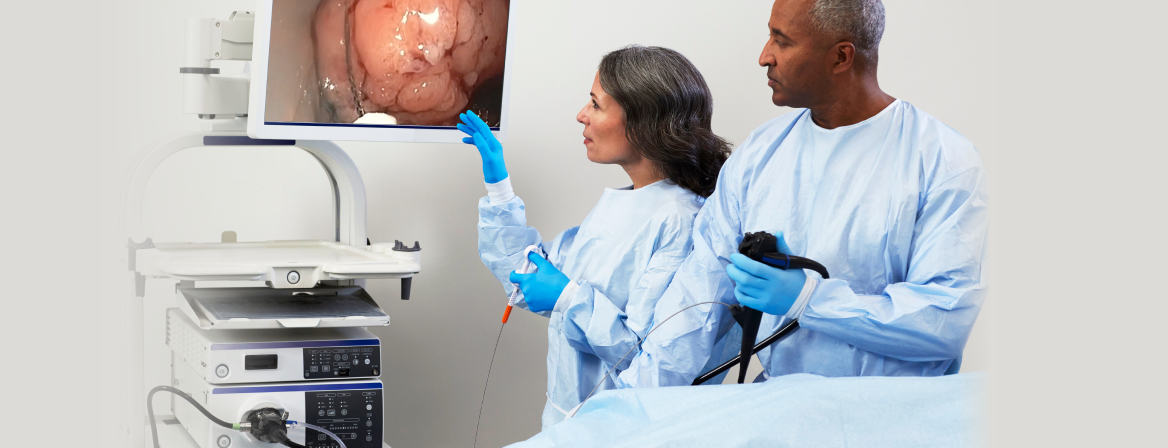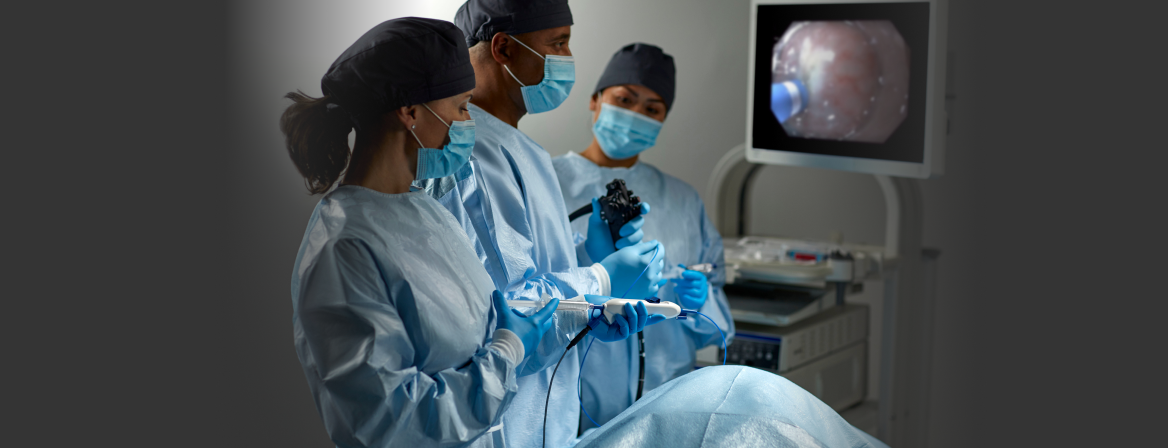Boston Scientific accounts are for healthcare professionals only.
The American Society for Gastrointestinal Endoscopy (ASGE) and Boston Scientific surveyed endoscopists about advanced tissue resection – specifically Endoscopic Mucosal Resection (EMR) and Endoscopic Submucosal Dissection (ESD) – and their views on training, reimbursement, barriers and more. This report describes and presents the results of the survey. While the future is bright for these procedures, keeping up with what’s next starts now.
Methodology
ASGE and Boston Scientific collaborated on a survey of 113 U.S.-based advanced therapeutic endoscopists, conducted online from March 8 to May 23, 2023. Please note that a majority of respondents are ASGE members who may have more experience than industry average. All respondents perform EMR as a requirement of the survey.
EMR includes cap- or ligation-assisted (banding) removal of a lesion in the upper or lower GI tract. The procedure requires three main steps: submucosal injection to lift the lesion; demarcation of the lesion; and endoscopic snare resection.
Innovative procedures demand lifelong learning
EMR training
Although fellowship training is beginning to include EMR, the landscape continues to evolve.
58% of respondents interested in receiving additional EMR training at*
- ASGE STAR course
- Industry-sponsored program
- GI society-sponsored program
A need for more training courses
Staff EMR training
Endoscopy nurses and techs are highly skilled in EMR through on-the-job training, yet survey responses indicate a need for more formal programs.
“Hands-on training with live demonstrations would benefit my staff.”
– Mid/late-career endoscopist at community hospital
The future of EMR
Adoption expectations
* Respondents could select more than one answer.
ESD is an effective, minimally invasive technique to treat neoplasms in the GI tract. The approach enables en bloc removal of large lesions – through dissection of the submucosa – with a curative intent.1 For nearly 40% of respondents, integrating ESD into practice remains too big a challenge.
Many respondents report low ESD procedural volume
A demand for more learning
ESD training
While fewer respondents have trained in ESD compared to EMR, there’s a clear demand for more training to gain more expertise – even for those already performing ESD.
“Proctorship is needed more. Case discussion and tips during hands-on sessions would be great."
– Mid/late-career endoscopist at academic medical center
Concern around procedure readiness
Staff ESD training
GI nurses and techs have completed fewer ESD training programs compared to EMR, which has led to less learning.
“My team would benefit from seeing how other providers perform ESD.”
– Mid/late-career endoscopist at academic medical center
* Respondents could select more than one answer.
ESD can be more effective than EMR for challenging GI cases.2 So what’s holding survey respondents back from integrating it into practice? Turns out the answer is just as complex as the procedure.
Steep learning curve and lack of patients
Procedure barriers
For endoscopists looking to overcome ESD’s steep learning curve, having a lack of patients creates an even stiffer challenge.
“ESD is a complex procedure with a steep learning curve, only a few training facilities and not enough cases in my community hospital.”
– Mid/late-career endoscopist at community hospital
Inadequate payment and challenging process
Reimbursement barriers
Endoscopists seeking better reimbursement continue to face daunting claims submission, with 50% and 52% of respondents reporting inadequate reimbursement and a challenging claims process, respectively, as reasons for not performing ESD.
Familiarity with Medicare’s HCPCS Code C9779
used by hospitals to report ESD procedures performed in the outpatient setting.
The future of ESD
Adoption expectations
“I do expect ESD, like EMR, to become an essential part of endoscopic training, like ERCP years ago.”
– Mid/late-career endoscopist at academic medical center
* Respondents could select more than one answer.
This report shows that the advanced tissue resection approaches propelling interventional endoscopy are on a steady yet arduous path to adoption. That's good news for patients wanting to avoid surgery.
Respondents indicated several challenges to integrating EMR and ESD into practice. Organizations like ASGE and industry partners like Boston Scientific work to help endoscopists and facilities overcome those barriers and enhance the clinical experience – all while bringing awareness of en bloc resection benefits to multi-disciplinary settings. Support includes:
- Offering in-depth, hands-on training for GIs and staff
- Advocating for a unique ESD CPT code
- Providing field-based reimbursement education
With EMR and ESD continuing to advance, what’s next is now. The data collected from this survey will inform new strategies as we move the field forward, offer more training opportunities and advocate for a unique ESD CPT code and ICD-10-PCS codes for ESD in our efforts to help hospitals decrease the overall cost of care.
“Endoscopic societies and industry must recognize the need for comprehensive training and education on how to perform these procedures.”
– Mid/late-career endoscopist at community hospital
About
American Society for Gastrointestinal Endoscopy
Since its founding in 1941, the American Society for Gastrointestinal Endoscopy (ASGE) has been dedicated to advancing patient care and digestive health by promoting excellence and innovation in gastrointestinal endoscopy. ASGE, with almost 16,000 members worldwide, promotes the highest standards for endoscopic training and practice, fosters endoscopic research, recognizes distinguished contributions to endoscopy, and is the foremost resource for endoscopic education.
Boston Scientific
Boston Scientific is dedicated to transforming lives through innovative medical solutions that improve the health of patients around the world. To support your advanced endoscopy education journey, your Boston Scientific representative can direct you to a wealth of training tools for you and your teams that range from wet labs, staff CNE trainings, proctorships, preceptorships and hands-on courses that can help you learn the right techniques, tools and proficiency at the right times.
Agree to disagree
A range of opinons on the future of EMR and ESD
"As long as gastroenterologists recognize EMR’s advantages over surgical resection and incomplete endoscopic resection – plus the endoscopists who perform the procedures proficiently – then adoption should expand."
"The GI community is fairly unpredictable and generally slow at adopting new techniques and procedures that do not offer a financial incentive."
“There’s a lot of trepidation to pursue more aggressive, higher risk procedures that are time intensive and inadequately reimbursed. This is particularly true for ESD.”
"As EMR techniques improve, more physicians will be comfortable."
"ESD requires a special set of skills. With innovation and new technology to make it safer and easier, it’s likely to be more available."
"The only way for ESD adoption to increase is through improved reimbursement and devices that reduce complexity and risks."
"ESD will continue to be performed only by a few and mostly in academics due to risks."
"An increase in the number of therapeutic endoscopists will lead to more complex procedures being done in the community."
"ESD is already getting adopted but as more therapeutic endoscopists get trained, adoption will grow rapidly."
"ESD tools and methods will continue to improve and more adoption will be seen."
1. Maple JT., Abu Dayyeh BK, Murad FM. et al. Technology Status Evaluation Report: Endoscopic submucosal dissection. GIE Journal Volume 81, Issue 6, 1311-1325 (2015). https://doi.org/10.1016/j. gie.2014.12.010
2. Park YM., Cho E., Kang HY. et al. The effectiveness and safety of endoscopic submucosal dissection compared with endoscopic mucosal resection for early gastric cancer: a systematic review and metaanalysis. Surg Endosc 25, 2666–2677 (2011). https://doi.org/10.1007/s00464-011-1627-z
Health economic and reimbursement information provided by Boston Scientific Corporation is gathered from third-party sources and is subject to change without notice as a result of complex and frequently changing laws, regulations, rules, and policies. This information is presented for illustrative purposes only and does not constitute reimbursement or legal advice. Boston Scientific encourages providers to submit accurate and appropriate claims for services. It is always the provider’s responsibility to determine medical necessity, the proper site for delivery of any services, and to submit appropriate codes, charges, and modifiers for services rendered. It is also always the provider’s responsibility to understand and comply with Medicare national coverage determinations (NCD), Medicare local coverage determinations (LCD), and any other coverage requirements established by relevant payers which can be updated frequently. Boston Scientific recommends that you consult with your payers, reimbursement specialists, and/or legal counsel regarding coding, coverage, and reimbursement matters. Boston Scientific does not promote the use of its products outside their FDA-approved label. Information included herein is current as of January 2023 but is subject to change without notice.
Current Procedural Terminology (CPT) 2022 American Medical Association. All rights reserved. CPT is a registered trademark of the American Medical Association. Applicable FARS/DFARS Restrictions Apply to Government Use. Fee schedules, relative value units, conversion factors and/or related components are not assigned by the AMA, are not part of CPT, and the AMA is not recommending their use. The AMA does not directly or indirectly practice medicine or dispense medical services. The AMA assumes no liability for data contained or not contained herein.
CAUTION: The law restricts these devices to sale by or on the order of a physician. Indications, contraindications, warnings, and instructions for use can be found in the product labelling supplied with each device or at www.IFU-BSCI.com. Products shown for INFORMATION purposes only and may not be approved or for sale in certain countries. This material not intended for use in France.
All trademarks are the property of their respective owners.
www.bostonscientific.com
2023 Copyright © Boston Scientific Corporation or its affiliates.
All rights reserved.




